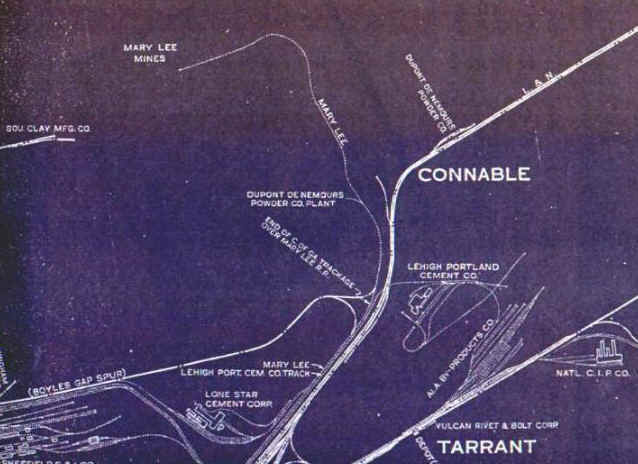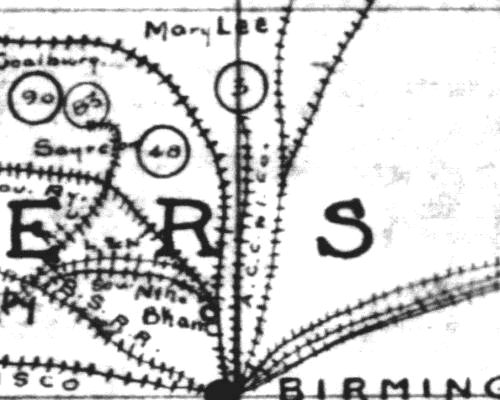Mary Lee Railroad and Mines
 The
Mary Lee RR is an interesting piece of local railroad history. Today,
known as the Jefferson Warrior RR, this industrial short line has been around
about as long as Birmingham. Like many aspects of the industrial history
of our City, the Mary Lee has a complex heritage. That is, its
ownership has gone through a series of mergers and acquisitions as
industrial property changed hands over the years.
The
Mary Lee RR is an interesting piece of local railroad history. Today,
known as the Jefferson Warrior RR, this industrial short line has been around
about as long as Birmingham. Like many aspects of the industrial history
of our City, the Mary Lee has a complex heritage. That is, its
ownership has gone through a series of mergers and acquisitions as
industrial property changed hands over the years.
The map at right shows the Mary Lee as it existed in 1935. By this time, the MLRR had become part of the holdings of the Sloss Companies, since 1924. But research indicates that it started as a very early part of the industrial heritage of Birmingham's coal and iron industry.
As of May, 2004, the history of the Mary Lee is a work in progress. I invite readers to submit additional information, or better yet, images to help tell this story.
So, who was Mary Lee, and why was a railroad named after her? According to the Birmingham District, the Mary Lee RR was named for Mary Lee Boyles, daughter of Bartholomew Boyles, an Irish construction engineer who worked for John T. Milner, and helped him to develop the South and North RR, later the L&N RR. This early north-south route was planned in 1858-59 to open up the Birmingham District from Montevallo to Decatur. (Many readers will recognize that the Boyles classification yard of the L&N carries this name.) The South & North line was not actually completed through to Decatur until 1872.
In the 1870's, Boyles purchased land in the area north of Birmingham for farming, but soon began to develop coal mining interests in the area. Apparently a spur line was extended to the Lewisburg mine site, and became the Mary Lee Railroad.
John Milner also had coal interests in this area, at Coalburg. Coalburg was on the main line of the Georgia Pacific RR. Originally developed as part of the Milner Coal and Railway Company, the Coalburg properties were sold to the Georgia Pacific 1883.
In 1884, Milner and partners purchased land at
Newcastle located northeast of Coalburg, but on the L&N main line.
Milner built a home near Newcastle, worked at developing the mines, and became a
state Senator. He continued to work at economic development of the area,
until his death in 1898. However, the Newcastle properties were served by
the main line of the L&N and not by the Mary Lee.
The Mary Lee properties were acquired by the Alabama Consolidated Coal Company by 1899. The map at right is dated 1908 and indicates that the ACC&I Co. operated a private rail line to the Mary Lee mines.
Prior to that the Jefferson Coal and RR Company and the Lewisburg Coal and Coke Company apparently built rail connections to connect Lewisburg with Birmingham about 6 miles to the south.
The Birmingham District account of this development concludes (page 289) that Alabama Consolidated Coal Company continued to operate the Lewisburg mine properties. In October, 1924, Alabama Consolidated Coal Company was acquired by the Sloss Sheffield Steel and Iron Company.
By this time, 1924, Sloss operated the Sloss City Furnaces (Sloss Furnace Museum today), the North Birmingham Furnaces, and in 1918, built the Sloss coke works and by-products plant in North Birmingham. Sloss had other properties outside the Birmingham District and was one of the largest of the early iron producers in Birmingham. The Mary Lee Railroad tied these properties together, although it is a complex operation involving dedicated track as well as trackage right operations on other railroads.
Parallel History in the District, complementing the history of the Mary Lee RR. (Begins about 15 pages of maps.)
Operations on the Mary Lee RR, courtesy of Mr. Bob Irvin. (You will skip over numerous maps, but may come back.)
Mary Lee Mine Site, a map study and aerial photos.
Industrial Site Ruin, facility along the Mary Lee tracks Can you figure out what it is?
Intriguing RR device, found in the woods along the Mary Lee. Can you figure out what it is?